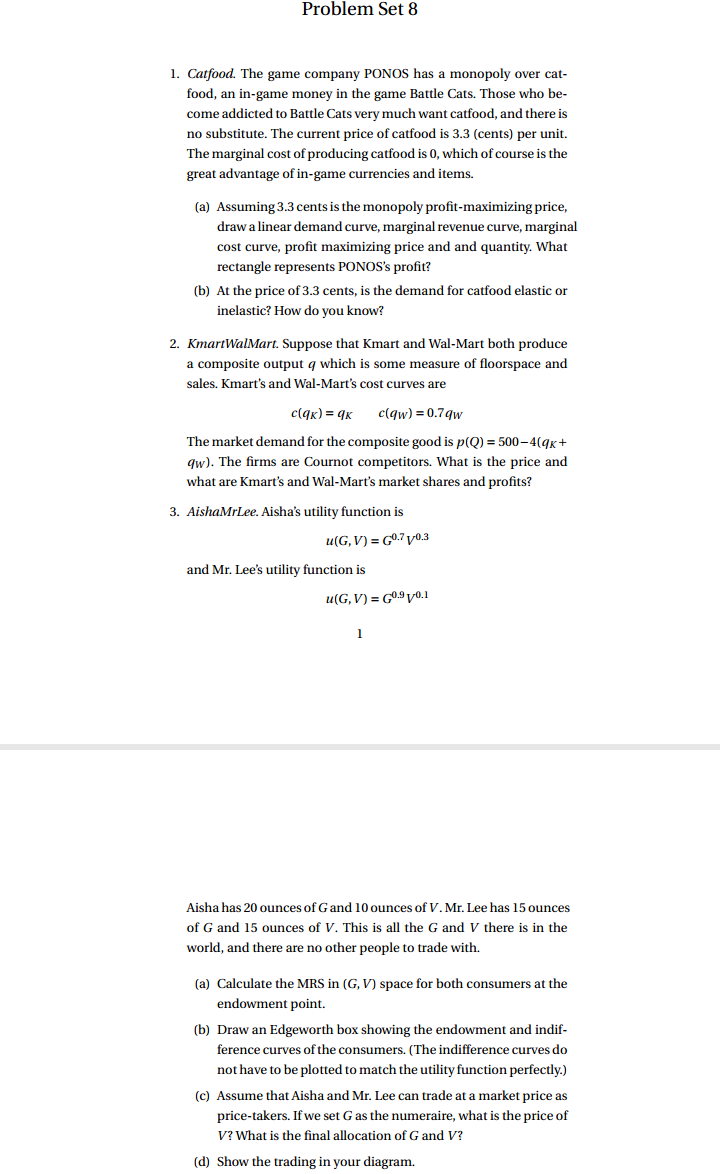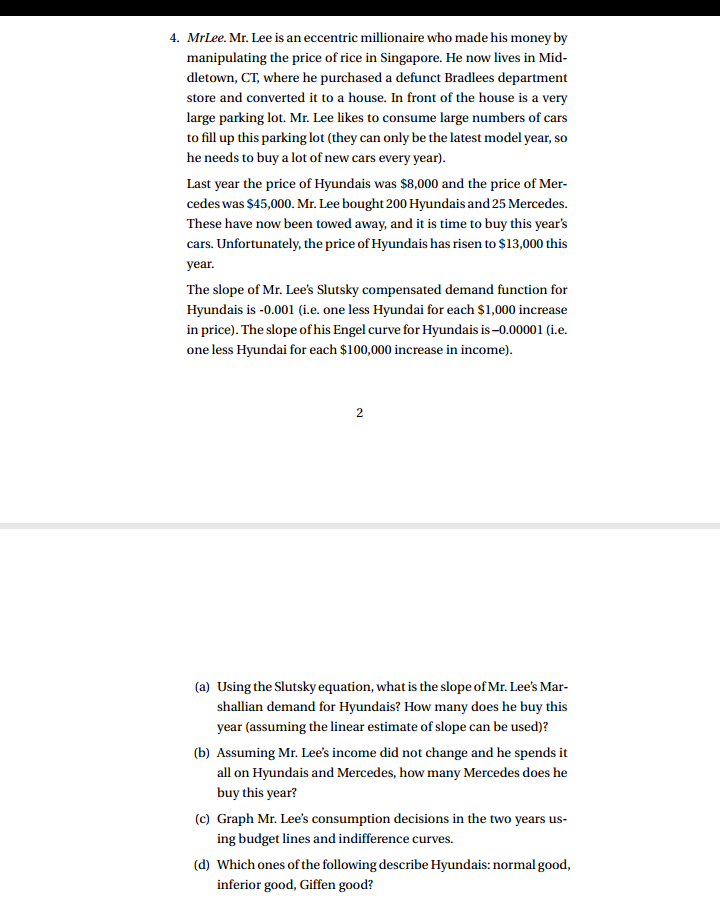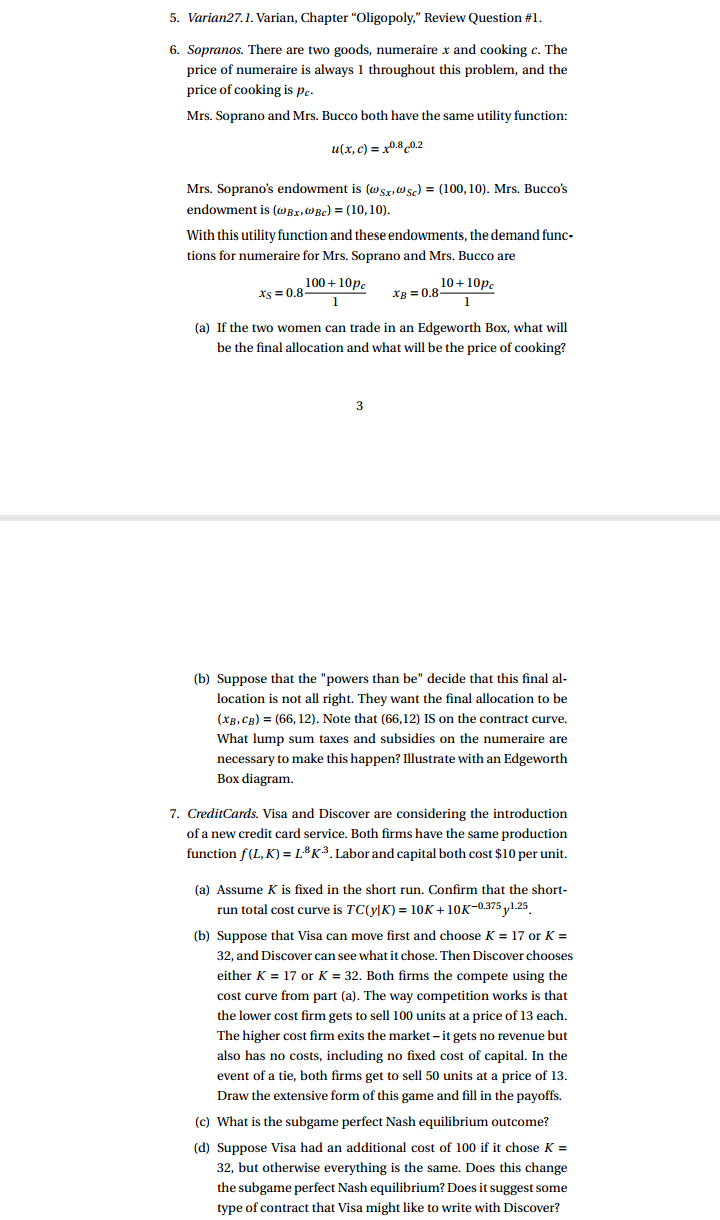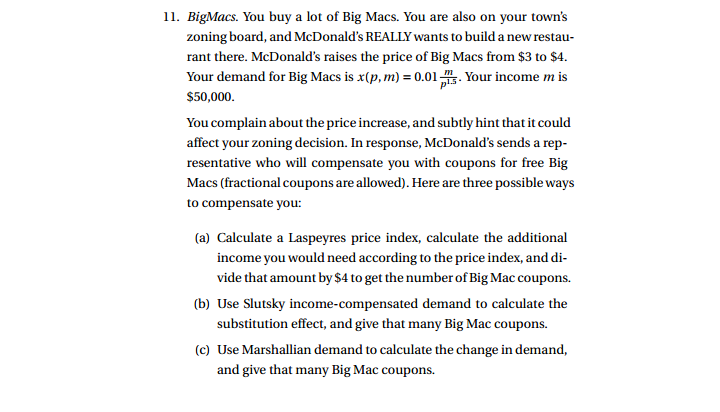




Someone assist in answering these
Problem Set 8 1. Catfood. The game company PONOS has a monopoly over cat- food, an in-game money in the game Battle Cats. Those who be- come addicted to Battle Cats very much want catfood, and there is no substitute. The current price of catfood is 3.3 (cents) per unit. The marginal cost of producing catfood is 0, which of course is the great advantage of in-game currencies and items. (a) Assuming 3.3 cents is the monopoly profit-maximizing price, draw a linear demand curve, marginal revenue curve, marginal cost curve, profit maximizing price and and quantity. What rectangle represents PONOS's profit? (b) At the price of 3.3 cents, is the demand for catfood elastic or inelastic? How do you know? 2. KmartWalMart. Suppose that Kmart and Wal-Mart both produce a composite output q which is some measure of floorspace and sales. Kmart's and Wal-Mart's cost curves are c(qx) = qx c(qw) =0.7qw The market demand for the composite good is p(Q) = 500-4(qx+ qw). The firms are Cournot competitors. What is the price and what are Kmart's and Wal-Mart's market shares and profits? 3. AishaMrLee. Aisha's utility function is u(G, V) = G0.7 V0.3 and Mr. Lee's utility function is U(G, V) = G0.9 V0.1 Aisha has 20 ounces of G and 10 ounces of V. Mr. Lee has 15 ounces of G and 15 ounces of V. This is all the G and V there is in the world, and there are no other people to trade with. (a) Calculate the MRS in (G, V) space for both consumers at the endowment point. (b) Draw an Edgeworth box showing the endowment and indif- ference curves of the consumers. (The indifference curves do not have to be plotted to match the utility function perfectly.) (c) Assume that Aisha and Mr. Lee can trade at a market price as price-takers. If we set G as the numeraire, what is the price of V? What is the final allocation of G and V? (d) Show the trading in your diagram.4. MrLee. Mr. Lee is an eccentric millionaire who made his money by manipulating the price of rice in Singapore. He now lives in Mid- dletown, CT, where he purchased a defunct Bradlees department store and converted it to a house. In front of the house is a very large parking lot. Mr. Lee likes to consume large numbers of cars to fill up this parking lot (they can only be the latest model year, so he needs to buy a lot of new cars every year). Last year the price of Hyundais was $8,000 and the price of Mer- cedes was $45,000. Mr. Lee bought 200 Hyundais and 25 Mercedes. These have now been towed away, and it is time to buy this year's cars. Unfortunately, the price of Hyundais has risen to $13,000 this year. The slope of Mr. Lee's Slutsky compensated demand function for Hyundais is -0.001 (i.e. one less Hyundai for each $1,000 increase in price). The slope of his Engel curve for Hyundais is -0.00001 (i.e. one less Hyundai for each $100,000 increase in income). (a) Using the Slutsky equation, what is the slope of Mr. Lee's Mar- shallian demand for Hyundais? How many does he buy this year (assuming the linear estimate of slope can be used)? (b) Assuming Mr. Lee's income did not change and he spends it all on Hyundais and Mercedes, how many Mercedes does he buy this year? (c) Graph Mr. Lee's consumption decisions in the two years us- ing budget lines and indifference curves. (d) Which ones of the following describe Hyundais: normal good, inferior good, Giffen good?5. Varian27.1. Varian, Chapter "Oligopoly," Review Question #1. 6. Sopranos. There are two goods, numeraire x and cooking c. The price of numeraire is always 1 throughout this problem, and the price of cooking is Pc- Mrs. Soprano and Mrs. Bucco both have the same utility function: u(x, c) = 10.8 20.2 Mrs. Soprano's endowment is (@sx,(sc) = (100, 10). Mrs. Bucco's endowment is (@Ex, (Bc) = (10, 10). With this utility function and these endowments, the demand func- tions for numeraire for Mrs. Soprano and Mrs. Bucco are X's = 0.8- 100 + 10pc XB = 0.8- 10 + 10pc (a) If the two women can trade in an Edgeworth Box, what will be the final allocation and what will be the price of cooking? (b) Suppose that the "powers than be" decide that this final al- location is not all right. They want the final allocation to be (XB, CB) = (66, 12). Note that (66,12) IS on the contract curve. What lump sum taxes and subsidies on the numeraire are necessary to make this happen? Illustrate with an Edgeworth Box diagram. 7. CreditCards. Visa and Discover are considering the introduction of a new credit card service. Both firms have the same production function f(L, K) = L.#K-. Labor and capital both cost $10 per unit. (a) Assume K is fixed in the short run. Confirm that the short- run total cost curve is TC(y|K) = 10K + 10K-0.375 y.1.25 (b) Suppose that Visa can move first and choose K = 17 or K = 32, and Discover can see what it chose. Then Discover chooses either K = 17 or K = 32. Both firms the compete using the cost curve from part (a). The way competition works is that the lower cost firm gets to sell 100 units at a price of 13 each. The higher cost firm exits the market - it gets no revenue but also has no costs, including no fixed cost of capital. In the event of a tie, both firms get to sell 50 units at a price of 13. Draw the extensive form of this game and fill in the payoffs. (c) What is the subgame perfect Nash equilibrium outcome? (d) Suppose Visa had an additional cost of 100 if it chose K = 32, but otherwise everything is the same. Does this change the subgame perfect Nash equilibrium? Does it suggest some type of contract that Visa might like to write with Discover?(c) What is the subgame perfect Nash equilibrium outcome? (d) Suppose Visa had an additional cost of 100 if it chose K = 32, but otherwise everything is the same. Does this change the subgame perfect Nash equilibrium? Does it suggest some type of contract that Visa might like to write with Discover? 8. Pate. There are two goods, beef (B) and goose liver pate (G). The typical French person has an endowment of @g = 50, @G = 50 and a utility function U(B, G) = B0-3GO.7. The typical American has an endowment of @g = 70,@G = 30 and a utility function U(B, G) = B0.8. Note that the typical American simply does not receive utility from the pate. (a) What is the typical French and American MRS in (B,G) space at the endowment points? (b) Draw an Edgeworth box and show indifference curves for each type of consumer. Show the core and the contract curve. 9. Pareto. Is it possible to have a Pareto efficient allocation where someone is worse off than he is at an allocation that is not Pareto efficient? Illustrate with an Edgeworth Box. 10. RichAndPoor. A very rich person and a very poor person are going to trade in an Edgeworth box. The rich person is named Ms. 1 and her origin is the lower left corner. The poor person is named Mr. 2 and his origin is the upper right hand corner. The two people will trade good y (on the vertical axis) and good x (on the horizontal axis). Ms. 1 has the entire endowment of good x, and there is a lot of that good. Mr. 2 has the entire endowment of good y, but there is not that much of it. Both people's indifference curves indicate that good y doesn't bring very much utility compared to good x. (a) Draw the Edgeworth box, showing the endowment point, in- difference curves, and the contract curve. What is the Wal- rasian equilibrium? Is it efficient? (b) Suppose the government values equality and wants the fi- nal outcome of trading to be the allocation approximately in the center of the box. Show a government price control that forces the center point to be in the budget sets of both con- sumers. How does this change the Walrasian equilibrium? Is "equality" achieved? Is this solution efficient. (c) Can the government use the Second Fundamental Theorem of Welfare Economics to improve on part (b)?11. BigMacs. You buy a lot of Big Macs. You are also on your town's zoning board, and Mcdonald's REALLY wants to build a new restau- rant there. McDonald's raises the price of Big Macs from $3 to $4. Your demand for Big Macs is x(p, m) = 0.01 =]. Your income m is $50,000. You complain about the price increase, and subtly hint that it could affect your zoning decision. In response, Mcdonald's sends a rep- resentative who will compensate you with coupons for free Big Macs (fractional coupons are allowed). Here are three possible ways to compensate you: (a) Calculate a Laspeyres price index, calculate the additional income you would need according to the price index, and di- vide that amount by $4 to get the number of Big Mac coupons. (b) Use Slutsky income-compensated demand to calculate the substitution effect, and give that many Big Mac coupons. (c) Use Marshallian demand to calculate the change in demand, and give that many Big Mac coupons
















